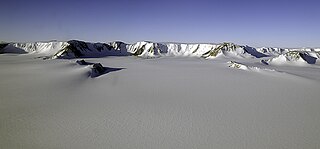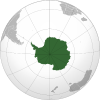
The Shackleton Range is a mountain range in Antarctica that rises to 1,875 metres (6,152 ft) and extends in an east–west direction for about 100 miles (160 km) between the Slessor and Recovery Glaciers.
Mount Absalom is the southernmost and highest mountain of the Herbert Mountains, in the central part of the Shackleton Range. It was first mapped in 1957 by the Commonwealth Trans-Antarctic Expedition (CTAE) and named for Henry W.L. Absalom, a member of the Scientific Committee on the CTAE of 1955–58.
Mount Lowe is a mountain having two peaks, the highest rising to 990 metres (3,250 ft), on the south side of the mouth of Blaiklock Glacier in the west part of the Shackleton Range, Antarctica. It was first mapped in 1957 by the Commonwealth Trans-Antarctic Expedition and named for Wallace G. Lowe, a New Zealand photographer with the transpolar party of the expedition in 1956–58.
Mount Sheffield is a rocky mountain, 915 m, at the junction of Gordon and Slessor Glaciers on the north side of the Shackleton Range. It was first mapped in 1957 by the Commonwealth Trans-Antarctic Expedition and named for Alfred H. Sheffield, the chairman of the radio communications working group for the IGY, who was of great assistance in this field to the Commonwealth Trans-Antarctic Expedition of 1955–58.
Pratts Peak is a rock peak in Antarctica located 11 kilometres (6.8 mi) east of Mount Provender in the west part of Shackleton Range. It was first mapped in 1957 by the CTAE and it was photographed in 1967 by U.S. Navy trimetrogon aerial photography. It was named by the United Kingdom Antarctic Place-Names Committee (UK-APC) for David L. Pratt, engineer, and John G. D. Pratt, geophysicist, who were with the transpolar party of the Commonwealth Trans-Antarctic Expedition in 1956–58.
Mount Provender is a conspicuous rock mountain, 900 m, marking the northwest extremity of the Shackleton Range. It was first mapped in 1957 by the Commonwealth Trans-Antarctic Expedition and so named because members of the Commonwealth Trans-Antarctic Expedition established a depot of food and fuel and an airplane camp on the south side of the mountain in 1957 to support sledging parties working in the Shackleton Range.
Williams Ridge is a conspicuous rock ridge, 1,060 m, extending east–west between Blaiklock and Stratton Glaciers, 1 nautical mile (1.9 km) northwest of Honnywill Peak in the west part of the Shackleton Range. First mapped in 1957 by the Commonwealth Trans-Antarctic Expedition and named for Sgt. Ellis Williams, RAF, radio operator with the advance party of the Commonwealth Trans-Antarctic Expedition in 1955–56 and with the RAF contingent of the expedition in 1956–58.
The Blaiklock Glacier is a glacier 16 nautical miles (30 km) long, flowing north from Turnpike Bluff, then northwest to Mount Provender and Mount Lowe in the western part of the Shackleton Range, Antarctica.

Otter Highlands is a group of peaks and ridges extending northwest-southeast for 17 nautical miles from Mount Lowe to Wyeth Heights, located west of Blaiklock Glacier and forming the west end of the Shackleton Range. Surveyed by the Commonwealth Trans-Antarctic Expedition in 1957. Named by the United Kingdom Antarctic Place-Names Committee (UK-APC) in 1972 after the De Havilland Otter aircraft which supported the CTAE.
Nostoc Lake is a lake lying 1 nautical mile (1.9 km) southwest of Mount Provender in the west part of the Shackleton Range. It was first mapped in 1957 by the Commonwealth Trans-Antarctic Expedition and given the generic name of the freshwater alga found growing in the lake.
Mount Weston is the highest peak of Haskard Highlands, in the west part of the Shackleton Range. It was first mapped in 1957 by the Commonwealth Trans-Antarctic Expedition and named after Flight Sgt. Peter D. Weston, RAF, an aircraft mechanic with the RAF contingent of the Commonwealth Trans-Antarctic Expedition in 1956–58.
Cornwall Glacier is a glacier 9 nautical miles (17 km) long, flowing south from Crossover Pass in the Shackleton Range to join Recovery Glacier east of Ram Bow Bluff.
The Stratton Glacier is a glacier 20 nautical miles (37 km) long, flowing north from Pointer Nunatak and then northwest to the north of Mount Weston, in the Shackleton Range of Antarctica.
Turnpike Bluff is a conspicuous rock formation in the Shackleton Mountains of Antarctica.
Mount Greenfield is an ice-free mountain rising to 1,490 metres (4,890 ft) and surmounting the western extremity of Stephenson Bastion in the Shackleton Range of Antarctica. It was mapped in 1957 by the Commonwealth Trans-Antarctic Expedition (CTAE) and named after George C. Greenfield, a literary agent of the CTAE from 1955 to 1958.
Mount Pivot is a conspicuous mountain, 1,095 m, with steep rock slopes on its west side, standing between Mount Haslop and Turnpike Bluff in the west part of the Shackleton Range. It was first mapped in 1957 by the Commonwealth Trans-Antarctic Expedition and so named because this prominent landmark was the turning point for aircraft and sledging parties of the expedition rounding the southwest end of the Shackleton Range.
Glen Glacier is a glacier at least 7 nautical miles (13 km) long, flowing south in the Shackleton Range of Antarctica to join Recovery Glacier to the west of the Read Mountains.
Mount Haslop is a mountain, 760 metres (2,500 ft) high, which stands 2 nautical miles (4 km) south of Mount Lowe at the western extremity of the Shackleton Range in Antarctica. It was first mapped in 1957 by the Commonwealth Trans-Antarctic Expedition (CTAE) and named for Flight Lieutenant Gordon M. Haslop, Royal New Zealand Air Force (1922–1961), New Zealand second pilot of the Royal Air Force contingent of the CTAE in 1956–58.
Mount Homard is a mountain 1,200 metres (3,900 ft) high, near the head of Blaiklock Glacier, 2 nautical miles (4 km) south of the Trey Peaks in the western part of the Shackleton Range, Antarctica. It was first mapped in 1957 by the Commonwealth Trans-Antarctic Expedition and was named for Sergeant Major Desmond E.L. Homard, an engineer with the advance and transpolar parties of the expedition, 1955–58.

La Grange Nunataks is a scattered group of nunataks extending west for 22 nautical miles (41 km) from the mouth of Gordon Glacier, on the north side of the Shackleton Range, Antarctica. They were first mapped in 1957 by the Commonwealth Trans-Antarctic Expedition (CTAE), and were photographed in 1967 by U.S. Navy aircraft. They were named by the UK Antarctic Place-Names Committee for Johannes J. La Grange, a South African meteorologist with the CTAE. Not: Beney Nunataks.
 This article incorporates public domain material from "Mount Beney". Geographic Names Information System . United States Geological Survey.
This article incorporates public domain material from "Mount Beney". Geographic Names Information System . United States Geological Survey. 


